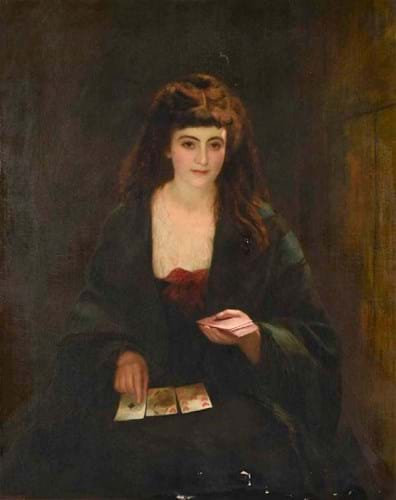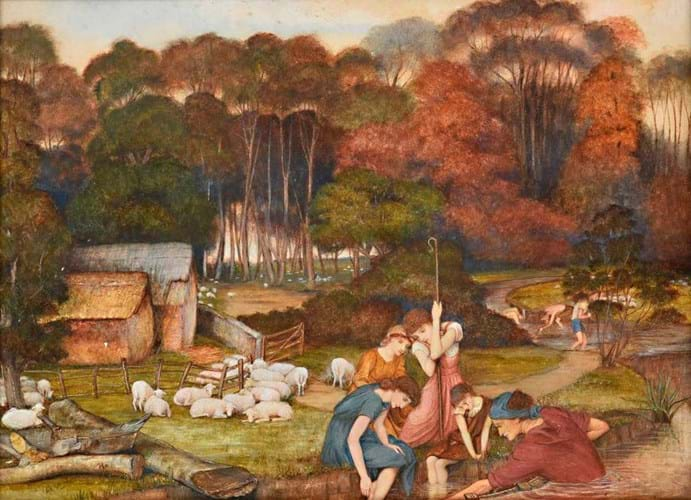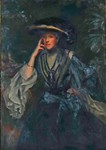A couple of Victorian examples appeared at Tennants (22% buyer’s premium) of Leyburn, North Yorkshire, as part of a consignment of paintings, furniture, period silver and ceramics from a private deceased estate in Penrith, Cumbria.
One was The Fortune Teller, a picture of a young woman with a deck of cards by William Powell Frith (1819-1909).
The artist is most famous for his large and supremely detailed panoramas showing crowded scenes of Victorian life such as Derby Day, his best-known painting. Another such work, Private View at the Royal Academy, thought to be the last of its kind in private hands, had been offered for a price in the region of £10m through St James’s gallery Martin Beisly in 2019 and was acquired by a UK collector.
But while these works brought Frith great fame, they were not produced in large number and pictures such as his more intimate female portraits provided a more reliable source of income throughout much of his career. They are also significantly more affordable on the current auction market.
Moralistic undertones
The picture at Tennants’ British, European and Sporting art sale on March 19, a 4ft 1in x 3ft 3in (1.25 x 1m) signed oil on canvas, dated from 1874 which meant it was slightly later than most of his panoramas which were produced mainly in the 1850s-60s.
While Frith had made his name with historical and literary scenes after moving to London in 1835, in the later part of his life he concentrated more on works with moralistic undertones.
He attempted to capture a broad cross-section of Victorian society from streetsweepers to the nobility. Depicting such ‘lowly’ figures including fortune tellers (one also appears in Derby Day) can be seen as part of his rebellious nature against conservative, upper-class taste which would not have considered them suitable subjects for high art.
The artist has strong connections to Yorkshire – he was born near Ripon, the son of a Harrogate hotelier – and retains a strong following in the area. The picture at Tennants, which was estimated at £7000-10,000, duly piqued the interest of a number of active participants both in the artist’s specific market and the Victorian sector more generally.
While the condition was not perfect – it suffered from a few losses the left edge and had some fairly rudimentary retouching especially to the lower half – the pitch was not regarded as excessive given the calibre of the artist and the market freshness of this picture.
It sold at £20,000. While it did not reach the heights of a somewhat brighter portrait of a lady with flowers sold for £50,000 at Cheffins in 2019, or a self-portrait that made the same sum at Sotheby’s in 2007, the price was still above average for a regular portrait by Frith in the current climate.
Shakespearean inspiration
From the same source came another Victorian picture, one of Thomas Francis Dicksee’s (1819-95) series of idealised portraits depicting Shakespearean heroines – in this case Cordelia from King Lear.
He exhibited a total of seven such works at the Royal Academy including Ophelia from 1864, one of his most famous works, and Miranda from 1881, a picture later sold at Sotheby’s New York in 2012 for $70,000 (£44,655).
The 19½ x 15½in (50 x 39cm) signed oil on canvas in Leyburn had a few condition issues. The canvas was slightly buckling and there were some areas of cracquelure, possibly due to it being exposed to a slightly damp environment as there was also evidence of mildew along the lower edge.
Despite this, again it was pitched at a level which enabled it to attract interest, in this case £7000-10,000 and it was knocked down at £13,000 to a UK private buyer.
Rural idyll
A private buyer also secured a third top-seller from the same collection: the watercolour Autumn by John Roddam Spencer Stanhope (1829-1908) which fetched a top-estimate £8000.
The idealised landscape with figures and sheep by a river had provenance to a Christie, Mason & Woods auction in 1904 as well to London dealer Thos Agnew & Sons and Newcastle’s The Stone Gallery.
Among the works from a separate vendor bringing interest was an interwar architectural portrait of Pilgrims Hall, Essex by Rex Whistler (1905-44).
Estimated at £5000-7000, it sold at £6500 to UK private buyer – see News Digest, ATG No 2537.
Another lot making a useful contribution to the bottom line, it helped the 141-lot sale at Tennants to a hammer total of £274,790 with an 88% selling rate, which was good going for an auction of primarily traditional art such as this.

















